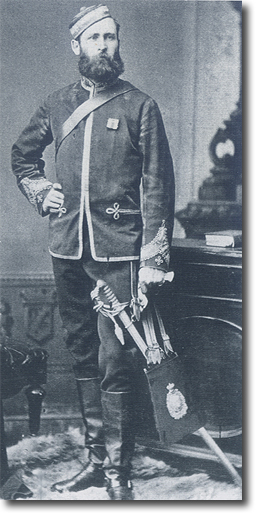|
|

 |
|
July 22, 1876 - October 31, 1880 James Farquharson Macleod was born in 1836 on the Isle of Skye in Scotland. Several years later his father moved the family to York County north of Toronto. Young Macleod went to Upper Canada College in Toronto, Queen's College in Kingston where he took his B.A. degree, then Osgoode Hall where he passed the bar examinations in 1860. By this time Macleod had developed a strong interest in the military and for the next decade, while practising law in Bowmanville, also served in the militia and advanced to the rank of major. In 1869 rebellion erupted among the Metis in the Red River Settlement in what is now south-eastern Manitoba. A force of British regulars and Canadian militia under Colonel Garnet Wolseley was sent by the Canadian government to quell the uprising. Macleod obtained a commission under Wolseley as brigade major and conducted himself so well on the expedition that he was decorated with the Order of St Michael and St George. In 1871 he was promoted to lieutenant-colonel. On September 25,1873, Macleod accepted a commission as superintendent in the newly established mounted police. In June of 1874 he was appointed the Force's first assistant commissioner, the second in command of the Force under Commissioner French. In the famous March West Macleod led his troops westward to the Belly River and established the first post of the mounted police in the Canadian northwest, later named Fort Macleod in his honour. He succeeded in suppressing the illicit whisky trade and winning the respect and confidence of both the aboriginals and whites on the frontier. On December 31, 1875 he resigned from the Force to become one of the first stipendiary magistrates of the newly created North-West Territories. Upon the resignation of French as commissioner in 1876, Macleod accepted the position. While commanding the NWMP, he continued to perform his duties as a stipendiary magistrate in the Bow River Judicial District. As Commissioner, he oversaw the moving of police headquarters to Fort Macleod, adopted a distinctive uniform and established a rank structure. His crowning achievement, however, was his tireless efforts to secure Alberta and Saskatchewan into Canada while peacefully negotiating Treaty No. 7 with the First Nations. He has been credited more than any other individual with establishing the policies followed by the North-West Mounted Police in their dealings with First Nations and with setting the tone of Canadian Indian policy in the North-West Territories. By 1880 however Macleod was dissatisfied with the government's efforts to fulfill the terms of the treaties, particularly with insufficient food being furnished to the destitute Indians. He lost confidence in the government and resigned from the Force on October 31, 1880. He continued to act as a magistrate and in 1887 was appointed a judge of the newly organized Supreme Court of the North-West Territories. He died September 5, 1894 and was buried at Calgary with full military honours. This photo of Macleod was taken in March 1879. He wears the NWMP officer's undress uniform of scarlet tunic fastened with hooks and eyes. His sleeve decoration designates his field officer rank. A brown leather pouchbelt with black leather binocular case on his back. Blue breeches with gold lace stripe. see Officer's Undress 1876 |
Armed Forces | Art and Culture | Articles | Biographies | Colonies | Discussion | Glossary | Home | Library | Links | Map Room | Sources and Media | Science and Technology | Search | Student Zone | Timelines | TV & Film | Wargames
